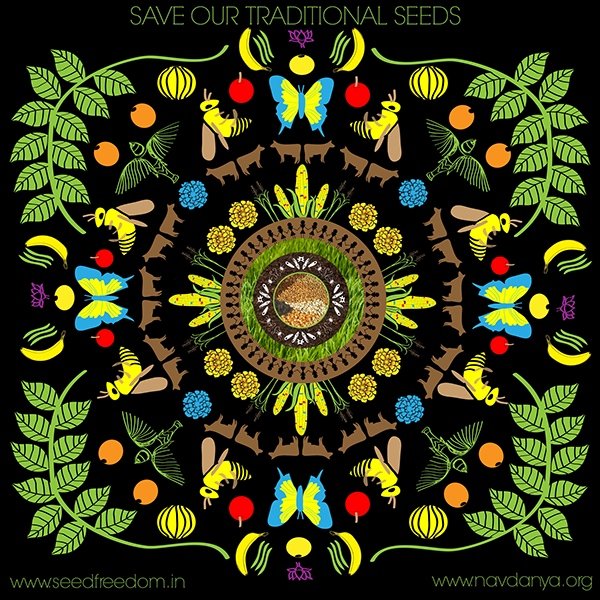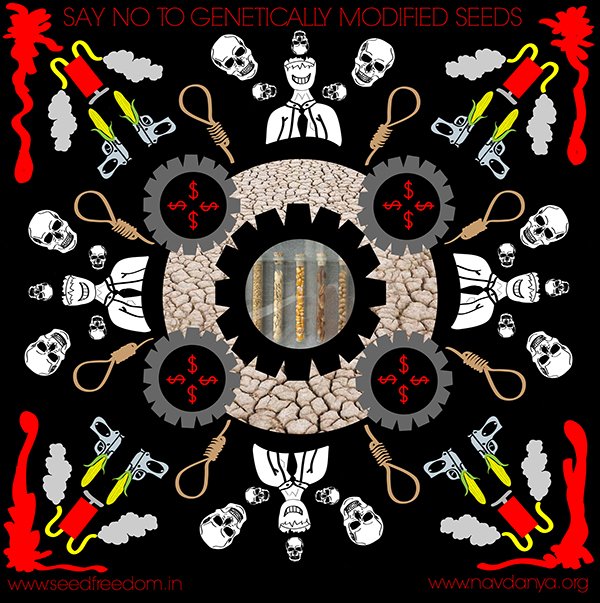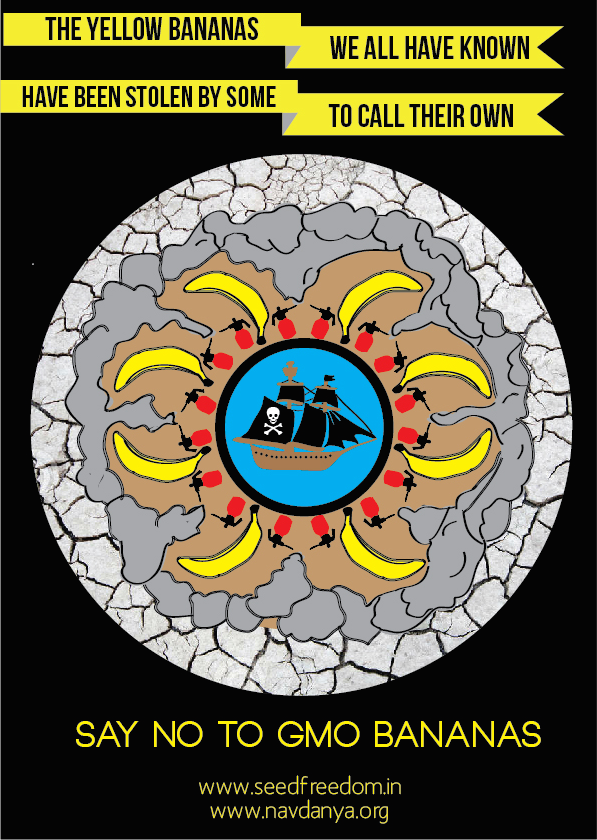
This post explores what the issues behind genetically modified organisms are and whether there are any solutions. The cover image is from pixabay.

Genetically modified organisms are made from seeds that have had their traits altered through genetic engineering. The intention behind them was to produce crop that was more resilient to detrimental factors, reducing the need for pesticides and fertilizers. Genetic modification by itself is not a bad thing and happens naturally as well through the art of crop breeding. A lot of the grains and millets we eat today have evolved from what were considered weeds. Farmers would select and reproduce the best performing crops from their fields as parents which over time would develop desirable traits in their offspring. Genetic engineering aimed on speeding up that process. That sounds good, but I feel the issues with GMOs aren't in modifying genes, but the way they are currently being used.

Breaking the Cycle
GMOs today are made to be non-reproductive. This means that farmers cannot save seeds for subsequent harvests and are thus locked into buying more seed from the companies supplying them. Seeds have been used as carriers of agriculture for centuries before this, and for the first time a farmer is forced to be dependent on external factors. This breaks a renewable cycle and forces farmers into a cycle of debt. This also promotes mono cropping, preventing new varieties from developing.
Toxic Chemical Use
GM crops are made to be resistant to the pesticides sold by the companies that made them. The pesticides are made from harmful chemicals that kill every other plant or pest around them. Weeds and pests also slowly develop resistance to the pesticide, which causes companies to release increasingly potent versions. The residue from these pesticides are often left behind in the food made from GM crops which is a major health concern.
Biopiracy
Biopiracy is when companies file patents on genetic traits that occur in plants, preventing their use without paying royalty to the company. This means that farmers that save and use their own seeds are still forced to pay companies if the crop has similar genetic traits to the ones they hold patents under. They are also liable to lawsuits even if a a crop gets pollinated from a GMO using neighbour.
Losing Indigenous Knowledge
By promising better yields, GM crops have caused a lot of people to forget their indigenous knowledge. There is a stunning amount of biodiversity available that can be utilized to solve a problem. Not too long ago, people had a deeper connection with their land and inherently understood how to address issues within it. For example, if a plant had a problem with a certain type of pest, farmers would know what to grow next to it that would kill the pests themselves or attract an animal or insect that did.
The way GMOs are being used now is fuelled by greed and only benefits corporations that are negligent of the adverse impact on the environment or human livelihoods on their pursuit of even more wealth.

Awareness
While a lot of people these days are more aware of the problems caused by how GMOs are used, a majority of farmers are still convinced they are superior to their local food crops. The first step in addressing the issue is making more farmers aware of how GMOs are being exploited for commercial gain by multinational corporations.
Participatory Plant Breeding
Participatory Plant Breeding was introduced to be a dynamic collaboration between scientists and farmers that unified traditional knowledge with modern methodologies. It involves farmers in the production of seeds, putting them in the center of a system that changes the relationship between release and adoption of crops.
The PPB team consists of breeders, scientists, social economists and anthropologists. They conduct studies on crops with superior genetic traits that are chosen by farmers who determine what is selling at the markets and what they want to grow. The best performing crops are then released to farmers to save, use, exchange or sell.

The PPB clients are farmers, small seed companies, consumers, NGOs and market specialists. It creates a direct relationship with seed producers and gives farmers the control they never had. It exists as a decentralized transparent breeding program that allows for the creation of variability while utilizing genetic modification.
Opinions on genetic modification are often divided into black and white. This system finds a balance and shows the good aspects of GM can be utilized while maintaining fair share policies. We wouldn't be having such a big GMO backlash if Monsanto adopted this system which could be a start as a possible solution to our problems with GMOs.

I was inspired by the course on agroecology at Navdanya, where I learnt about the PPB program and thought I could spread some awareness through creating art. I made these posters to highlight the difference between traditional seed use and how GMOs are being used now. I also made posters to aid a campaign by Navdanya in 2014 to prevent a patent on bananas.



 Navdanya used these posters for their campaign and I was thrilled that my art could be used to facilitate positive change and maybe bring about awareness on the issues we face. These images can also be found on their facebook page and behance.
Visit Seed Freedom and Navdanya for further insight on the topic of GMOs
Navdanya used these posters for their campaign and I was thrilled that my art could be used to facilitate positive change and maybe bring about awareness on the issues we face. These images can also be found on their facebook page and behance.
Visit Seed Freedom and Navdanya for further insight on the topic of GMOs

 Seed Card Designs The Good News about Chennai's Seed Festival
Seed Card Designs The Good News about Chennai's Seed Festival



























On the surface this seems like a fair article. However it is subtly deceptive. It has a couple of earmarks from the pro GMO propaganda. This is not to say the author purposely was trying to deceive. Perhaps this author just doesn’t realize it or actually believes it. This is fairly common even among anti-GMO folks.
Ok I’ll get to it. The first one is that selective breeding or hybrid plants have nothing in common with GMO franken-fruits the propagandists are trying to tell us are safe. You can’t selectively breed fish genes into a tomato! This is what they are doing. They are splicing genes from incompatible species into fruits and vegetables to get the desired effects.
Second and more important is they use viruses to insert these genes into the cells. Because a virus is the only thing that can penetrate the cell wall without the organism’s immune system killing it off. Viruses ALWAYS mutate. So they are introducing all sorts of new viruses into the dance of life with no clue as to the consequences they will have on the environment and us and our animals etc. Think about that my friends.
Few people even among the anti-GMO folks know about the viruses being used to insert the genes. That is of course by design of the pro-gmo lobby. They have deep pockets and have convinced many farmers GMOs are better. However the stats do not bear that out. Production initially spikes but then tapers off and actually falls below what it once was.
The Pro GMO lobby has worked long and hard to convince folks Gene Splicing is the same as selective breeding so that it seems familiar and safe since selective breeding has been going on for centuries by humans and millennia by nature. IT’S NOT!!
Why does the GMO lobby fight so hard against labeling? Obviously they have something to hide. Do we not have a right to choose what we put into our bodies? Evidence is pretty conclusive now that GMO’s are harmful to the environment to animals and humans. I won’t belabor the point this is a polarizing subject unfortunately. I just emphasize to do your research. To many people have “beliefs” about GMOs without having done the research. It’s not a matter of belief its matter of facts and evidence. It’s available for those who want to know the truth.
The way forward is through Restoration Agriculture as per Mark Shepard and Permaculture as per Sepp Holzer and Geoff Lawton and many other lesser known pioneers in these areas. The earth has spent millions of years developing the fruits of the earth! Humans have been part of that too, we have much to learn from nature!
I did try and write this article without forcing my opinion on it and didn't realize it could be misleading by suggesting that GMOs are safe or a better alternative when I'm sure they aren't. What I meant to convey was that the terminology by itself is not negative. If farmers grow plant A next to plant B that produces plant C that is better than its parents, they are in a way modifying plant genetics, but through a natural process. Participatory plant breeding's aim is to modernize the practice of saving and distributing seed by selecting the best varieties from the multitudes of natural biodiversity and distribute them to a wider network. It's more about conserving traditional biodiversity and curating the best of it than messing around and splicing genes. The scientists involved are there more for research and academic purposes. These seeds that the PPB team co-creates perform much better than seeds from corporations and farmers benefit from the genetic modification done naturally by the careful selection of seed savers, sometimes across generations.
That's an important point you bring across about fish genes in tomatoes. There is much debate whether this is ethical. My opinion is that it is risky simply because nature is a wonderful magnificent thing that human perception cannot hope to comprehend. It's like a drop of water trying to understand the ocean. Who knows what the long term effects of this would be? I didn't know about the virus and subsequent mutations and that just makes the prospect of gene splicing even scarier.
I totally agree that the way forward is through bringing back our traditional indigenous knowledge with nature as our teacher. We all know by now that GM companies have made false claims and never delivered positive results. Permaculture is a bridge between our forgotten pasts and a sustainable future. I did also try and highlight the difference between the destruction GMOs are causing and the abundance and sustainability of natural and traditional farming through my art.
I'll also admit that I don't have much first hand experience or knowledge on GMOs and everything I write is from my own perspective and understanding. Everyone is free to form their own opinion.
Thank you for taking the time to add your insights here. You have very valid points by raising awareness in differentiating between artificial gene splicing and natural methods to create heirloom seeds. I respect your opinion and think your comment adds a lot of value to this post.
A thought provoking article. I'm glad @blaynesukut raised this though and that you were able to clarify the message you were aiming at as I have to admit I was a little perplexed myself. I was going to say that surely the old ways of cross pollinating to get the desired traits would be a better way to move forward while leaving the GMO companies out of it. I'm guessing that was what you were trying to say with the PPB though.
Yes, I wanted to show that genetic modification can be good if done using age old natural techniques. I think you're absolutely right that the old methods of getting desired traits are the ways to move forward. PPB aims on modernizing the ancient seed saving practice through networking and community without involving any multinational corporates. I didn't mean to accidentally promote GMOs. @blaynesukut raises an important point in making a distinction between natural and artificial GMOs which I didn't explicitly mention. I hope more people will realize that natural seeds are far superior to GMO counterparts and that you can have all the benefits of genetic modification without the destruction, greed and damage GMO corporations are currently causing.
Thanks for responding and clarifying your position.
Like I said I thought the article was pretty fair. However I pointed out the things I did because they show how powerful the pro GMO lobby is with their propaganda. If they can get most people to associate The GMO franken fruits and veggies with natural and selective breeding of plants they know it eases fears.
They have been very successful at it. Most people have been swayed by it and are not that concerned about GMO's because of it. You probably heard it or read it somewhere yourself and didn't think much of it. Most of us have at one time or another.
I reiterate the biggest problem is using viruses to insert genes. Even if the species are compatible. Their excuse behind it is; we've been doing it for years with plant breeding this just speeds up the process. The problem is most people do not know they are using viruses to insert genes.
Also bypassing the natural breeding process of compatible species can have all sorts of unintended consequences.
When people talk about heirloom fruits and veggies many people think these are natural and appeared on the planet just as they are. They are not they are a product of selective propagation or breeding. People just chose to propagate the best specimens and cull the others. So they have evolved over time and using nature.
These viruses are now in the ecosystem of the planet. We don't know what effect they may have. I feel we may be heading for a catastrophic crisis in the food supply if we don't change course soon. Time will tell.
Thanks for the amicable response you have my respect too!
Respect!
Congratulations @soulturtle! You have completed some achievement on Steemit and have been rewarded with new badge(s) :
Click on any badge to view your own Board of Honor on SteemitBoard.
For more information about SteemitBoard, click here
If you no longer want to receive notifications, reply to this comment with the word
STOP